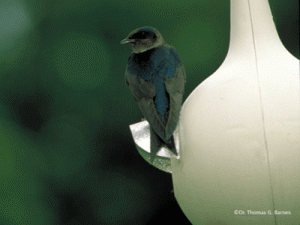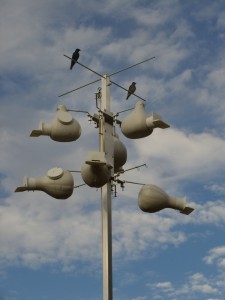Joan Hagar from the U.S. Geological Survey and I went out to the Dunn Forest purple martin colony last Friday to band this year’s nestlings. Each bird had a numbered, aluminum band attached to its left leg and a color band (red) attached to its right. Joan will submit these data to the USGS Bird Banding Laboratory so that any future re-sightings of these purple martins will add to our understanding of movements, lifespan, and mortality factors for the species. The color bands are coded for different regions around the western states and British Columbia. While working at the site, dozens of yellow-jacket wasps were attracted to our activity which certainly didn’t make the delicate task of banding the nestlings any easier. We actually watched a wasp chase a purple martin in flight for more than a minute as he circled the gourd rack!
 This year we banded 30 nestlings, making a total of 53 birds banded from this colony during the last 3 years. What is especially remarkable is that every egg laid in any of the artificial gourds has hatched and survived to fledge—an incredible rate of nesting success. This year we also re-sighted the first banded adult at the colony. She is a two-year old female who was banded at the Fern Ridge colony in Lane County, Oregon.
This year we banded 30 nestlings, making a total of 53 birds banded from this colony during the last 3 years. What is especially remarkable is that every egg laid in any of the artificial gourds has hatched and survived to fledge—an incredible rate of nesting success. This year we also re-sighted the first banded adult at the colony. She is a two-year old female who was banded at the Fern Ridge colony in Lane County, Oregon.
The purple martin is rare in the Willamette Valley of Oregon, but is more common along the coast and at areas along the Columbia River. It is listed as a state-sensitive species by Oregon Department of Fish and Wildlife. The Dunn Forest colony is especially important because martins continue to nest in snag cavities. While hundreds of thousands of martin nests are monitored across North America every year, less than 100 are in snags. Martins have become entirely dependent on artificial gourds and nest boxes except at a few sites on the west coast.
 The Dunn Forest martin colony site is located adjacent to agricultural lands from which starlings are migrating toward the forest edge. We observed many instances of starlings competing against martins for use of snag cavities and it was feared the reproductive success of martins would be impacted. In 2011 OWI placed a small number of gourds and nest boxes with starling-resistant entrances to ensure that the colony will always have a few sites available that are inaccessible to starlings. We continue to observe a growing number of unbanded 1- and 2-year old martins at the colony, evidence that martins are probably breeding at snags yet undiscovered by us in the surrounding forest.
The Dunn Forest martin colony site is located adjacent to agricultural lands from which starlings are migrating toward the forest edge. We observed many instances of starlings competing against martins for use of snag cavities and it was feared the reproductive success of martins would be impacted. In 2011 OWI placed a small number of gourds and nest boxes with starling-resistant entrances to ensure that the colony will always have a few sites available that are inaccessible to starlings. We continue to observe a growing number of unbanded 1- and 2-year old martins at the colony, evidence that martins are probably breeding at snags yet undiscovered by us in the surrounding forest.
See a video of the Dunn Forest purple martin colony .
Our conservation activities for purple martins have been supported by the Oregon Wildlife Heritage Foundation. If you would also like to support our efforts, please use our “Contact” page on our website to email me for further details. The Oregon Wildlife Institute is a 501(c)(3) tax-exempt organization.



